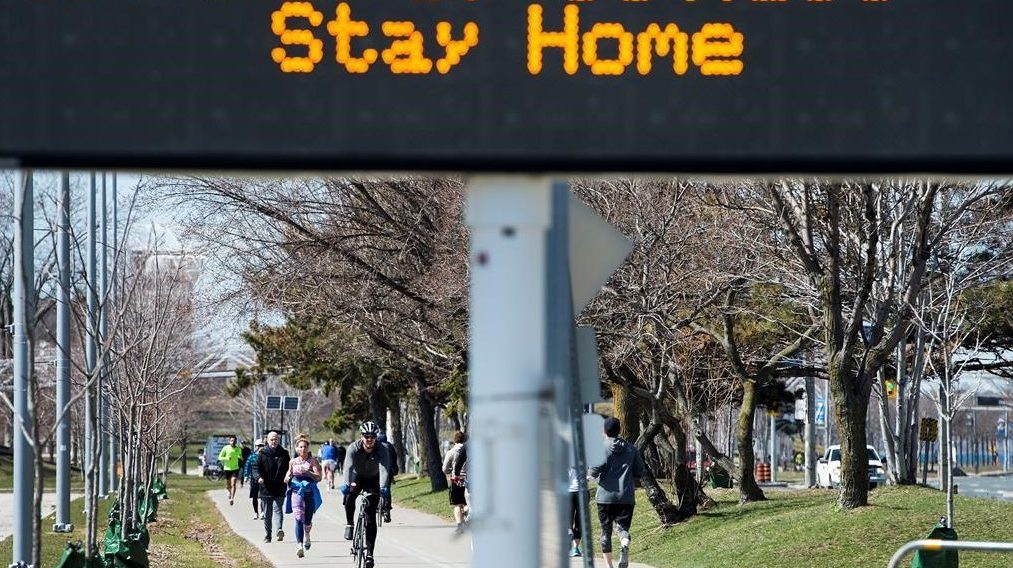
The top doctors of three COVID-19 hot spots in Ontario are urging the province to impose tougher restrictions, including a stay-at-home order, to address a surge in new infections.
Posted Apr 06, 2021, 05:25AM EDT
The top doctors of three COVID-19 hot spots in Ontario are urging the province to impose tougher restrictions, including a stay-at-home order, to address a surge in new infections.
The chief medical officers of health for Toronto, Peel Region and Ottawa made the recommendations in a letter to Dr. David Williams, the province’s top doctor.
“A stay-at-home order issued by the province through an Emergency Order is necessary to prevent and mitigate large scale morbidity and mortality and irreparable strain on the health-care system,” said the letter signed by Dr. Eileen da Villa, Dr. Lawrence Loh and Dr. Vera Etches.
The letter comes just days after Premier Doug Ford’s government imposed a provincewide month-long shutdown that critics argue does not go far enough to address more transmissible variants of concern.
The three doctors also appealed to Williams to move schools to online learning in regions with significant COVID-19 outbreaks, remove businesses from the list of essential services, and implement 50 per cent staffing limits for those businesses deemed essential.
I am asking each and every one of you to help us get this virus under control.
Mask up. Keep your distance. #StayHome
We have come too far, Ottawa. (5/5) pic.twitter.com/NRvqNKdbYi
— Dr. Vera Etches (@VeraEtches) April 5, 2021
They also asked the government to impose travel restrictions between regions within Ontario and for the province to provide paid sick days to supplement the federal program.
The Ontario Medical Association also joined the calls for stricter measures and a stay-at-home order to address the increase in COVID-19 cases.
“The consequences of not doing so could include more people sick and dying than we have experienced thus far; so many so, that doctors could no longer care for everyone,” said Dr. Samantha Hill, the group’s president.
A spokeswoman for Health Minister Christine Elliott said the shutdown was aimed at dealing with the third wave of the pandemic, but noted it takes time for the intended effects of the measures to be realized due to the incubation period of the virus.
But some public health leaders appeared to have lost patience with the province’s approach.
Loh of Peel Region used his powers under Ontario’s public health legislation Monday to order local schools closed for in-person learning.
All schools in Brampton, Caledon and Mississauga will move to remote learning for at least two weeks, starting on Tuesday, Loh said.
“With increasing case counts and the presence of variants of concern, we need to break chains of transmission and keep our schools safe,” Loh said in a statement.
The decision to close schools in the region did not sit well with Brampton Mayor Patrick Brown.
“Don’t close elementary schools. Vaccinate educators,” he tweeted Monday.
Instead of closing schools, Brown suggested closing workplaces like Amazon, food processing plants, big box stores and factories.
“If our supply chain can’t handle it, then vaccinate essential workers. Same old approach isn’t working,” he said.
If schools are being closed because they are a #COVID19 risk then why are we not vaccinating educators during this multi week closure. Currently, they are slated for June. This makes no sense. Vaccinate educators NOW so that we can reopen schools. @ETFOPeel @OSSTFD19 @dpsuoecta
— Patrick Brown (@patrickbrownont) April 5, 2021
The president of the Elementary Teachers’ Federation of Ontario said all schools in hot spot regions should move to online learning until all teachers can be vaccinated.
“As medical experts have said, there is no excuse—no valid reason—to not begin vaccinating all essential workers today; this includes all education workers,” Sam Hammond said in a statement.
A spokesperson from Education Minister Stephen Lecce said the province firmly believes that schools should remain open for in-class learning as they are critical for students’ metal health.
Meanwhile, Toronto Mayor John Tory said the city was working on a plan to bring the COVID-19 vaccine to high-risk workplaces using mobile vaccination units.
Tory stressed that the plan was contingent on the availability of vaccine supply in the coming weeks.
“We hope to be able to take it to workplaces … where we know there’s a higher risk just given all the circumstances, and to other areas where we know people are more vulnerable,” Tory said.
Ontario’s vaccine rollout began in December and focused initially on immunizing some of the province’s oldest residents in long-term care and health-care workers.
In recent months, it has shifted in a descending order through the oldest age groups in the province, with Toronto now starting to give the shot to people 60 years and older at its six mass vaccination sites.
But increasingly, experts in the health-care sector say essential workers who cannot work from home and often cannot self-isolate if they contract the illness should be prioritized for the shot.
ICU doctors have said many of the patients they’re treating these days are essential workers who got infected in the workplace.
The province said 494 patients were in intensive care because of COVID-19 and 293 on a ventilator – 44 new patients were admitted in ICUs on Sunday.
Ontario reported nearly 6,000 new COVID-19 cases over a two-day span – 2,938 new cases on Monday and 3,041 cases on Sunday – and 22 deaths.
There were 942 people hospitalized with the virus during the same period, though the Ministry of Health noted that 10 per cent of Ontario’s hospitals do not submit data on weekends.
With files from Denise Paglinawan and Holly McKenzie-Sutter

